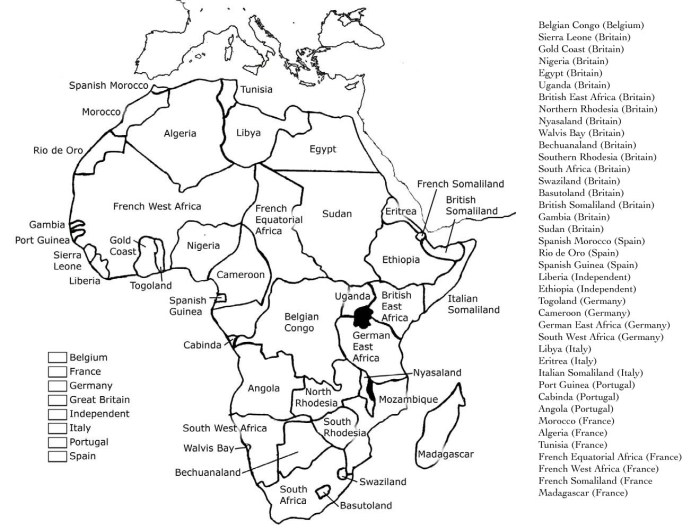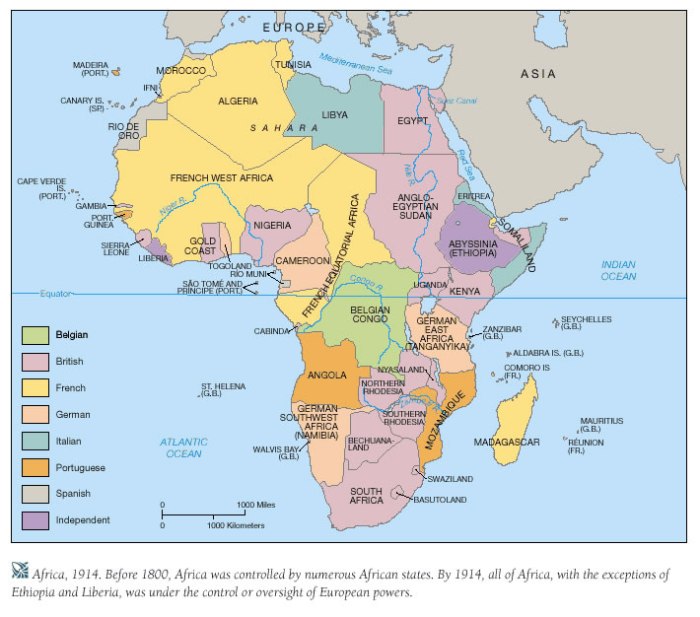Embark on a journey through time with our africa in 1914 map worksheet, an invaluable resource for understanding the continent’s political, physical, economic, and cultural landscapes during a pivotal era.
This meticulously crafted worksheet provides a detailed overview of Africa’s colonial borders, major cities, physical features, economic activities, and cultural diversity, offering a comprehensive understanding of the continent’s history and geography.
Africa in 1914: Political Map

Africa in 1914 was a continent divided, with European powers controlling vast swathes of territory. This map provides a detailed overview of the political boundaries and major cities of Africa in 1914.
The map highlights the extent of European colonialism in Africa, with the continent divided among a handful of European powers. The major European powers with colonies in Africa in 1914 were:
- United Kingdom
- France
- Germany
- Italy
- Portugal
- Spain
- Belgium
The map also shows the locations of the major cities in Africa in 1914. These cities were often the centers of European colonial administration and economic activity.
Africa in 1914



Africa in 1914 was a vastly different place than it is today. The continent was divided among a handful of European powers, and the borders of many countries were still being contested. The physical features of Africa, however, have remained largely unchanged.
Africa in 1914 was a complex landscape of colonial powers and indigenous kingdoms. To understand the region’s history, it’s helpful to study maps that depict its political boundaries. After delving into the intricacies of Africa’s colonial era, consider exploring ac theory level 1 lesson 7 to enhance your understanding of electrical concepts.
This lesson provides a comprehensive overview of alternating current theory, which is essential for analyzing and designing electrical circuits. By studying both Africa in 1914 and ac theory, you’ll gain a deeper appreciation for the interconnectedness of history and science.
Africa in 1914: Physical Map
The map below shows the major physical features of Africa in 1914. The continent is dominated by the Sahara Desert in the north, the Congo Basin in the center, and the Kalahari Desert in the south. The Nile River, the longest river in the world, flows through the northeastern part of the continent.
The Congo River, the second-longest river in the world, flows through the central part of the continent. The Zambezi River, the fourth-longest river in the world, flows through the southern part of the continent.
The major mountain ranges in Africa include the Atlas Mountains in the north, the Drakensberg Mountains in the south, and the Ethiopian Highlands in the east. The highest mountain in Africa is Mount Kilimanjaro, which is located in Tanzania.
| Physical Feature | Location | Significance |
|---|---|---|
| Sahara Desert | Northern Africa | The largest hot desert in the world |
| Congo Basin | Central Africa | The second-largest rainforest in the world |
| Kalahari Desert | Southern Africa | The largest semi-arid desert in the world |
| Nile River | Northeastern Africa | The longest river in the world |
| Congo River | Central Africa | The second-longest river in the world |
| Zambezi River | Southern Africa | The fourth-longest river in the world |
| Atlas Mountains | Northern Africa | The highest mountain range in North Africa |
| Drakensberg Mountains | Southern Africa | The highest mountain range in Southern Africa |
| Ethiopian Highlands | Eastern Africa | The highest mountain range in East Africa |
| Mount Kilimanjaro | Tanzania | The highest mountain in Africa |
Africa in 1914



Africa in 1914 was a continent undergoing significant economic changes. European powers had established colonies across the continent, and these colonies were major sources of raw materials and agricultural products for the European economies. The African economy was also heavily dependent on the slave trade, which was still a major source of income for many African kingdoms and chiefdoms.
Despite the economic challenges, Africa was also a continent with a rich and diverse economy. The continent was home to a variety of agricultural products, including coffee, cocoa, and rubber. It also had a number of mineral resources, including gold, diamonds, and copper.
These resources were exported to Europe and other parts of the world, and they played a major role in the development of the global economy.
Africa in 1914: Economic Map
The map below shows the major economic activities and resources of Africa in 1914.

Major Economic Activities and Resources of Africa in 1914
The table below lists the major economic activities and resources of Africa in 1914, including their locations and a brief description of their importance.
| Economic Activity/Resource | Location | Importance |
|---|---|---|
| Agriculture | Throughout Africa | The primary economic activity in Africa, with crops such as coffee, cocoa, rubber, and cotton being major exports. |
| Mining | South Africa, Congo, Zambia | Gold, diamonds, and copper were major exports, providing wealth and economic growth. |
| Slave trade | West Africa, East Africa | A major source of income for many African kingdoms and chiefdoms, despite its negative social and economic impacts. |
| Fishing | Coastal regions | Provided food and income for coastal communities, with fish being exported to other parts of Africa and Europe. |
| Forestry | Central Africa, West Africa | Timber and other forest products were exported to Europe and other parts of the world, contributing to economic growth. |
Africa in 1914



Africa in 1914 was a continent of great cultural diversity, with hundreds of different ethnic groups and languages. The continent was also home to a number of major empires and kingdoms, each with its own unique culture and history.
Africa in 1914: Cultural Map, Africa in 1914 map worksheet
The map below shows the major cultural groups and languages of Africa in 1914.

The table below lists the major cultural groups and languages of Africa in 1914, including their locations and a brief description of their unique characteristics.
| Cultural Group | Language | Location | Unique Characteristics |
|---|---|---|---|
| Bantu | Bantu languages | Central and Southern Africa | The Bantu are a large group of peoples who speak Bantu languages. They are believed to have originated in West Africa and migrated to Central and Southern Africa over time. The Bantu are known for their agriculture, their ironworking, and their complex social structures. |
| Berber | Berber languages | North Africa | The Berber are a group of peoples who speak Berber languages. They are believed to have originated in North Africa and are related to the Semitic peoples. The Berber are known for their nomadic lifestyle, their sheepherding, and their traditional music. |
| Cushites | Cushitic languages | East Africa | The Cushites are a group of peoples who speak Cushitic languages. They are believed to have originated in the Horn of Africa and are related to the Semitic peoples. The Cushites are known for their agriculture, their herding, and their traditional crafts. |
| Khoisan | Khoisan languages | Southern Africa | The Khoisan are a group of peoples who speak Khoisan languages. They are believed to be the oldest inhabitants of Southern Africa. The Khoisan are known for their hunting and gathering lifestyle, their unique languages, and their rock art. |
| Nilo-Saharan | Nilo-Saharan languages | Central and Eastern Africa | The Nilo-Saharan are a group of peoples who speak Nilo-Saharan languages. They are believed to have originated in the Nile Valley and are related to the Bantu peoples. The Nilo-Saharan are known for their agriculture, their herding, and their traditional crafts. |
| Semitic | Semitic languages | North Africa and the Horn of Africa | The Semitic are a group of peoples who speak Semitic languages. They are believed to have originated in the Arabian Peninsula and are related to the Indo-European peoples. The Semitic are known for their agriculture, their trade, and their monotheistic religions. |
Popular Questions: Africa In 1914 Map Worksheet
What European powers had colonies in Africa in 1914?
The major European powers with colonies in Africa in 1914 were Britain, France, Germany, Portugal, Spain, Italy, and Belgium.
What were the major physical features of Africa in 1914?
The major physical features of Africa in 1914 included the Sahara Desert, the Congo River, the Nile River, the Great Rift Valley, and Mount Kilimanjaro.
What were the major economic activities in Africa in 1914?
The major economic activities in Africa in 1914 included agriculture, mining, and trade.